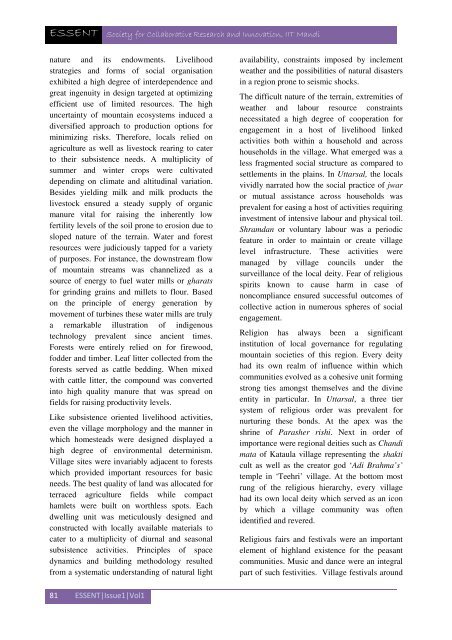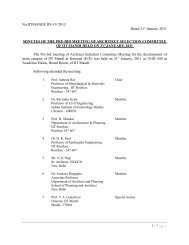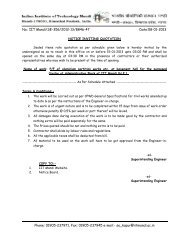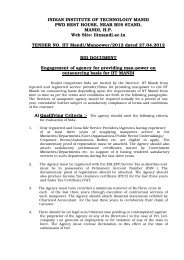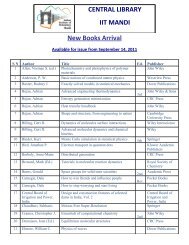Issue1. Vol.1 (April, 2013) - IIT Mandi
Issue1. Vol.1 (April, 2013) - IIT Mandi
Issue1. Vol.1 (April, 2013) - IIT Mandi
- No tags were found...
Create successful ePaper yourself
Turn your PDF publications into a flip-book with our unique Google optimized e-Paper software.
ESSENT Society for Collaborative Research and Innovation, <strong>IIT</strong> <strong>Mandi</strong>nature and its endowments. Livelihoodstrategies and forms of social organisationexhibited a high degree of interdependence andgreat ingenuity in design targeted at optimizingefficient use of limited resources. The highuncertainty of mountain ecosystems induced adiversified approach to production options forminimizing risks. Therefore, locals relied onagriculture as well as livestock rearing to caterto their subsistence needs. A multiplicity ofsummer and winter crops were cultivateddepending on climate and altitudinal variation.Besides yielding milk and milk products thelivestock ensured a steady supply of organicmanure vital for raising the inherently lowfertility levels of the soil prone to erosion due tosloped nature of the terrain. Water and forestresources were judiciously tapped for a varietyof purposes. For instance, the downstream flowof mountain streams was channelized as asource of energy to fuel water mills or gharatsfor grinding grains and millets to flour. Basedon the principle of energy generation bymovement of turbines these water mills are trulya remarkable illustration of indigenoustechnology prevalent since ancient times.Forests were entirely relied on for firewood,fodder and timber. Leaf litter collected from theforests served as cattle bedding. When mixedwith cattle litter, the compound was convertedinto high quality manure that was spread onfields for raising productivity levels.Like subsistence oriented livelihood activities,even the village morphology and the manner inwhich homesteads were designed displayed ahigh degree of environmental determinism.Village sites were invariably adjacent to forestswhich provided important resources for basicneeds. The best quality of land was allocated forterraced agriculture fields while compacthamlets were built on worthless spots. Eachdwelling unit was meticulously designed andconstructed with locally available materials tocater to a multiplicity of diurnal and seasonalsubsistence activities. Principles of spacedynamics and building methodology resultedfrom a systematic understanding of natural lightavailability, constraints imposed by inclementweather and the possibilities of natural disastersin a region prone to seismic shocks.The difficult nature of the terrain, extremities ofweather and labour resource constraintsnecessitated a high degree of cooperation forengagement in a host of livelihood linkedactivities both within a household and acrosshouseholds in the village. What emerged was aless fragmented social structure as compared tosettlements in the plains. In Uttarsal, the localsvividly narrated how the social practice of jwaror mutual assistance across households wasprevalent for easing a host of activities requiringinvestment of intensive labour and physical toil.Shramdan or voluntary labour was a periodicfeature in order to maintain or create villagelevel infrastructure. These activities weremanaged by village councils under thesurveillance of the local deity. Fear of religiousspirits known to cause harm in case ofnoncompliance ensured successful outcomes ofcollective action in numerous spheres of socialengagement.Religion has always been a significantinstitution of local governance for regulatingmountain societies of this region. Every deityhad its own realm of influence within whichcommunities evolved as a cohesive unit formingstrong ties amongst themselves and the divineentity in particular. In Uttarsal, a three tiersystem of religious order was prevalent fornurturing these bonds. At the apex was theshrine of Parasher rishi. Next in order ofimportance were regional deities such as Chandimata of Kataula village representing the shakticult as well as the creator god ‘Adi Brahma’s’temple in ‘Teehri’ village. At the bottom mostrung of the religious hierarchy, every villagehad its own local deity which served as an iconby which a village community was oftenidentified and revered.Religious fairs and festivals were an importantelement of highland existence for the peasantcommunities. Music and dance were an integralpart of such festivities. Village festivals around81 ESSENT|Issue1|Vol1


